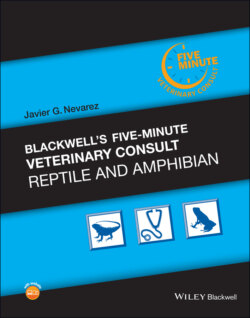Читать книгу Blackwell's Five-Minute Veterinary Consult: Reptile and Amphibian - Javier G. Nevarez - Страница 24
RESPIRATORY SYSTEM
ОглавлениеNasal conchae are absent in chelonians but are present in other reptiles. Crocodilians and chelonians have complete tracheal rings, while they are incomplete in snakes and lizards. The lung anatomy is one of three basic types. Unicameral lungs are simple, single‐chambered structures found in most snakes and some lizards, including tuataras. Paucicameral or transitional lungs have some internal divisions, but these are mostly incomplete and do not split the lung into separate chambers. They also lack intrapulmonary bronchus. Most iguanids, chameleons, and agamids have paucicameral lungs. Multicameral lungs are more complex with internal divisions and multiple bronchi. These lungs can be found in varanids, helodermatids, chelonians, and crocodilians. Chelonians have an exception as they possess a single, unbranched bronchus running the entire length of the lungs, with all lung chambers opening into this single bronchus.
In snakes, the lungs transform into an air sac structure caudally near the liver. In terrestrial species, the lung air sac terminates near the gallbladder, while in some aquatic species it terminates near the cloaca. In boids and colubrids, the respiratory portion is located between the heart and the cranial pole of the liver, while in most viperids and elapids there is a respiratory portion cranial to the heart. The right lung is always larger than the left. The left lung is well developed in boids and vestigial in colubrids. Multichambered lungs are found in the snake families Anomalepididae (primitive blind snakes), Typhlopidae (blind snakes), and Acrochordidae (primitive aquatic snakes from Australia and Indonesia).
Instead of alveoli, reptiles have faveolae (deeper than they are wide) and ediculae (wider than they are deep), which are exchange chambers that have a similar function to alveoli. Both are present in the lung tissue but absent in the air sacs. Reptiles have a large lung volume but only 10–20% of the surface area when compared with mammals of similar size. Ventilation is triphasic with a cycle of expiration, inspiration, and relaxation (breath holding) that creates a constant fluctuation of oxygen concentration in the lungs. Oxygen tension and temperature have a significant role in ventilation/respiration. At higher temperatures, there is an increased demand for oxygen, which leads to an increase in tidal volume. Respiratory rate increases at low oxygen tensions and decreases at high oxygen tension.
